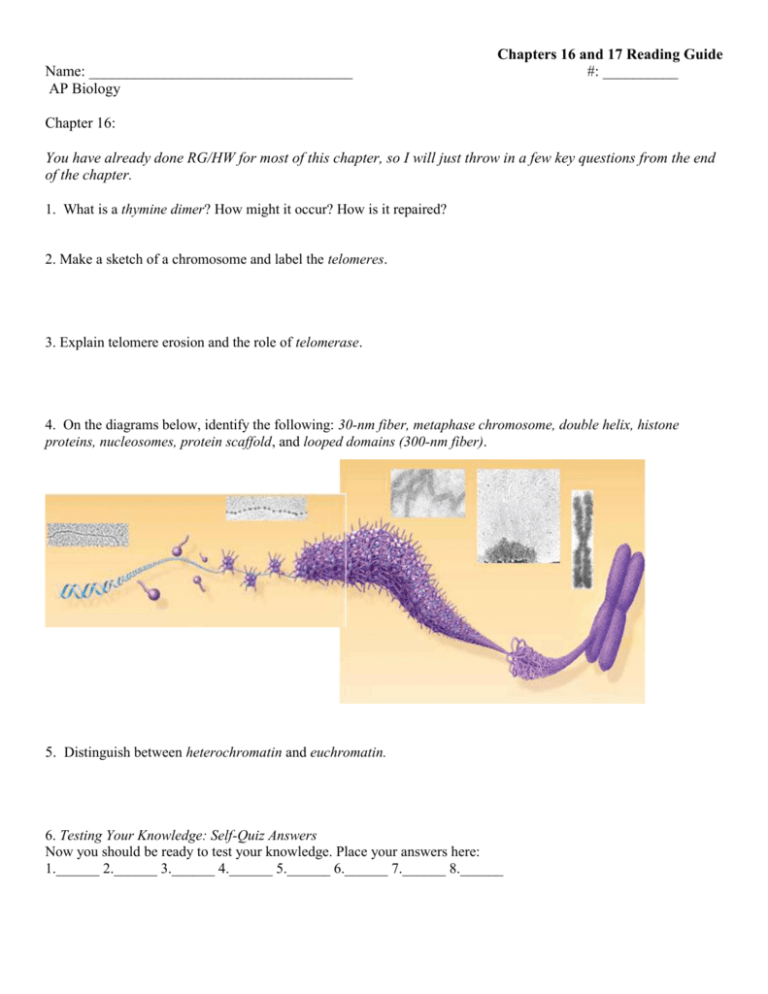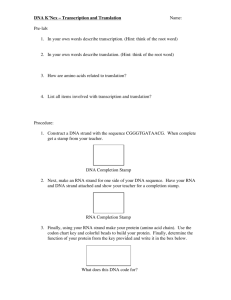AP Biology: Chapters 16 & 17 Reading Guide
advertisement

Name: ___________________________________ AP Biology Chapters 16 and 17 Reading Guide #: __________ Chapter 16: You have already done RG/HW for most of this chapter, so I will just throw in a few key questions from the end of the chapter. 1. What is a thymine dimer? How might it occur? How is it repaired? 2. Make a sketch of a chromosome and label the telomeres. 3. Explain telomere erosion and the role of telomerase. 4. On the diagrams below, identify the following: 30-nm fiber, metaphase chromosome, double helix, histone proteins, nucleosomes, protein scaffold, and looped domains (300-nm fiber). 5. Distinguish between heterochromatin and euchromatin. 6. Testing Your Knowledge: Self-Quiz Answers Now you should be ready to test your knowledge. Place your answers here: 1.______ 2.______ 3.______ 4.______ 5.______ 6.______ 7.______ 8.______ Chapter 17 Name: ___________________________________ Date: _____________ This one’s a bit lengthier because its more complex and involves a lot of different pieces. It is going to take you some time to get through this chapter… so don’t leave this until the last minute, please! 1. What is gene expression? Concept 17.1 Genes specify proteins via transcription and translation 2. State the hypothesis formulated by George Beadle while studying eye color mutations in Drosophila. 3. How were Neurospora spores treated to increase the mutation rate? 4. Study Figure 17.2 carefully. Using the figure to the right, outline the technique used to identify and isolate mutant fungi. 5. Cite two significant findings that resulted from the research of Beadle and Tatum. Basic Principles of Transcription and Translation 6. List three ways in which RNA differs from DNA. 7. Define each of these processes that are essential to the formation of a protein: transcription translation 8. In eukaryotes, what is the pre-mRNA called? 9. Write the central dogma of molecular genetics, as proclaimed by Francis Crick, in the box below. 10. How many nucleotides are required to code for these 20 amino acids? ___________________ 11. So, the language of DNA is a triplet code. How many unique triplets exist? ______________ 12. What is the coding strand called? 13. Describe Nirenberg’s experiment in which he identified the first codon. 14. What event is coded fro by UAA, UAG and UGA? ________________________________ 15. What is the start codon? ____________________________________________________ 16. Why is the genetic code said to be redundant but not ambiguous? 17. Explain the concept of reading frame. Concept 17.2 Transcription is the DNA-directed synthesis of RNA: A closer look 18. Name the enzyme that uses the DNA template strand to transcribe a new mRNA strand. ___________________ 19. You will recall from Chapter 16 that DNA polymerase III adds new nucleotides to the template DNA strand to assemble each new strand of DNA. Both enzymes can assemble a new polynucleotide only in the 5' direction. Which enzyme, DNA polymerase III or RNA polymerase, does not require a primer to begin synthesis? 20. What is a transcription unit? 21. Figure 17.7 in your text will require a bit of study. Use it to label the following elements on the figure below: promoter, RNA polymerase, transcription unit, DNA template, nontemplate DNA, and RNA transcript. 22. Let’s now take a closer look at initiation. Read the paragraph titled “RNA Polymerase Binding and Initiation of Transcription” carefully. List three important facts about the promoter here. (1) (2) (3) 23. Use Figure 17.8 in your text to label the following elements of the figure below: TATA box, RNA polymerase II, transcription factors, template DNA strand, start point, 5' and 3', and mRNA transcript. To the right of the figure, explain the three stages of initiation that are shown. 24. What is the TATA box? 25. What comprises a transcription initiation complex? Concept 17.3 Eukaryotic cells modify RNA after transcription 26. RNA processing occurs only in eukaryotic cells. The primary transcript is altered at both ends, and sections in the middle are removed. a. What happens at the 5' end? b. What happens at the 3' end? 27. What are three important functions of the 5' cap and poly-A tail? 28. On the figure below, label: pre-mRNA, 5' cap, poly-A tail, introns, and exons. 29. What are snRNPs? What two types of molecules make up a snurp? 30. You will be introduced to a number of small RNAs in this course. What type is the RNA in a snRNP? 31. On the figure below, label the following: pre-mRNA, snRNPs, snRNA, protein, spliceosomes, intron, and other proteins. 32. What is a ribozyme? 33. What commonly held idea was rendered obsolete by the discovery of ribozymes? 34. What are three properties of RNA that allow it to function as an enzyme? (1) (2) (3) Concept 17.4 Translation is the RNA-directed synthesis of a polypeptide: A closer look Name: ________________________________________ Date: ___________ 35. Use the figure below to explain the process of a specific amino acid being joined to a tRNA. Also add these labels: aminoacyl-tRNA synthetase, ATP, amino acid, and tRNA. 36. Describe the structure of a eukaryotic ribosome. 37. How does a prokaryotic ribosome differ from a eukaryotic ribosome? What is the medical significance of this difference? 38. On this figure, label the large subunit, small subunit, A, P, and E sites, mRNA binding site. To the right of the figure, explain the functions of the A, P, and E sites. 39. Summarize the events of initiation. 40. What is always the first amino acid in the new polypeptide? 41. Summarize the events of elongation 42. What is a polyribosome? 43. Describe at least three types of post-translational modifications. 44. Use the following figure to explain how proteins are targeted for the ER. . Concept 17.5 Point mutations can affect protein structure and function 45. Define point mutations. 46. What are frameshift mutations? 47. Identify two mechanisms by which frameshifts may occur. 48. What is the difference between a nonsense and missense mutation? 49. What are the two categories of mutagens? 50. Describe the action of difference types of chemical mutagens Concept 17.6 Although gene expression differs among the domains of life, the concept of a gene is universal 51. Describe two important ways in which bacterial and eukaryotic gene expression differ. Finally, use this summary figure to put together all that you have learned in this chapter. Testing Your Knowledge: Self-Quiz Answers Now you should be ready to test your knowledge. Place your answers here: 1. __________2.__________3. __________4. __________5. __________6. __________7. _________









